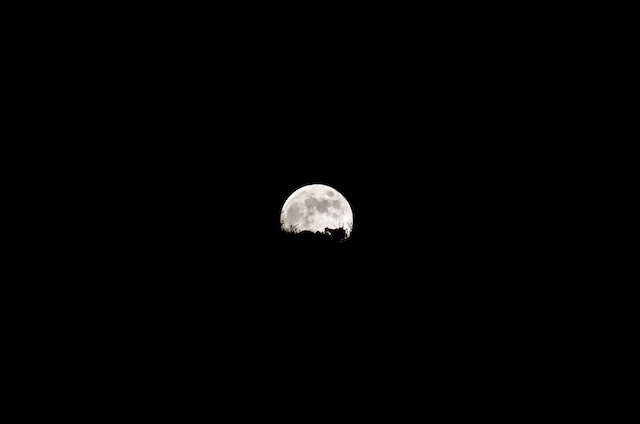
Really Full Moon, Moon in 3D
Last updated: 15 July 2011![[Home!]](../../../../../etx/images/mighty_etx_logo_orig-sm.jpg)
 |
Really Full Moon, Moon in 3DLast updated: 15 July 2011 |
![[Home!]](../../../../../etx/images/mighty_etx_logo_orig-sm.jpg) |
| Follow @mweasner | Welcome | Photos | Videos | Equipment | Links | Data |
Opened the observatory Thursday, 14 July, at 1845 MST, 95°F, under clear skies. The main goal of this night was to view and photograph the Full Moon. The moon would be at exactly its full phase at 2340 MST, and so well positioned for me. I have rarely had the opportunity to see the Really Full Moon except during total lunar eclipses.
At 1901 MST, viewed Mercury in the 26mm, 15mm, 9.7mm, and 5.5mm eyepieces. Its phase was a little less than "half". I set up for iPhone 4 afocal imaging using the MX-1 adapter. Here is a cropped frame from a video recording, 9mm eyepiece + 3X TeleXtender (666X):

At 1929 MST, viewed Saturn with the 26mm eyepiece. Then imaged it with the iPhone, 9mm + 3X TeleXtender. This is a cropped frame from a video recording:

Seeing was not very good this evening so these two images were not the best I have ever taken.
Finished imaging at 1951 MST and returned to viewing Saturn. Its moon Titan was now visible in the 26mm and 15mm eyepieces. At 1956 MST, two more moons appeared with the 15mm eyepiece: Tethys and Rhea. At 2007 MST, I began to see a glow in the southeast from the rising nearly Full Moon. At 2020 MST, the moon rose over the hill to the east, as captured by the D7000 DSLR, 300mm lens, f/5.6, 1/500sec:

At 2035 MST, viewed M63, the Sunflower Galaxy; it was faintly visible in the 26mm eyepiece against a bright sky. This is my next planned DSO imaging target, but it will have to wait until the moon is no longer a factor. So, I will have to wait a few more nights before imaging it. However, the monsoon storms are forecast to return within a few days, which will mess up my plans.
Began viewing the moon at 2043 MST in the 8" telescope. Used a moon filter with the 26mm eyepiece since the moon was so bright. The moon was still in the tree but a very slight terminator was still visible. At 2114 MST, switched to the visual back and took this iPhone afocal image:

At 2140 MST, two hours before Full Moon, the slight terminator was visible near the lunar south pole. Switched to the 5.5mm eyepiece to tour the moon. Although seeing was not good, there were some really nice views, especially along the limb where there was still a terminator showing. Ninety minutes before Full, there was still a little bit of a terminator visible.
About this time, I began hearing some noises in the observatory. I finally saw this large bug climbing a POD bay wall:

The shelf at the left is 1" tall, which gives you an idea of the size of this bug. Here is a close-up:

I have never seen a bug like this before. It was still in the POD bay when I closed the observatory. (The item at the end of the bug's right rear leg is some spider web material that it picked up in its travels.)
At 2217 MST, switched to the 9.7mm on the visual back to get a wider view of the terminator. One hour to Full Moon and the terminator was still visible. At 2301 MST, began setting up for D7000 DSLR prime focus imaging. Added a focal reducer in order to capture the moon's disk in the camera FOV. At 2340 MST, the precise time of the Full Moon, I took a series of images. Here is the 1/1000sec, ISO 100, exposure:

Click the image to see the full size version, 4928x3264 pixels, 1.5 MB.
At 2348 MST, took a final look at the Full Moon with the 26mm eyepiece + moon filter. Then closed the observatory at 2358 MST, 70°F.
Although it was unplanned, Bill Dillon (Twitter: @wdillon) and I both photographed the moon at almost the same time Wednesday night, 13 July, from two different locations. Bill is in Texas. Using the Arizona-Texas baseline, a slight 3D effect can be seen in the image below. Bill took the photo on the right with an iPhone on a 12" telescope. I took the photo on the left with the D7000 DSLR on my 8" telescope. Click the thumbnail to view a larger version and then use the "fusion" technique (cross your eyes and focus on the center image) to merge the two images into one. You will see the moon in 3D.

Go to the previous report.
Return to the Cassiopeia Observatory Welcome Page.